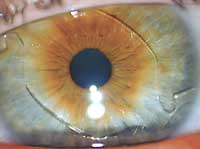Safety improved with second-generation phakic IOL
A revamped angle-supported foldable lens with thinner haptics and higher vaulting preserves endothelium and improves visual acuity.
LONDON – Adjustments made to the haptics and optic of an angle-supported phakic IOL for the correction of high myopia improve lens positioning and safety over the previous model, according to one ophthalmologist.
Béatrice Cochener, MD, of the University of Brest, presented early results from a study of the second-generation foldable, hydrophilic acrylic, phakic Icare IOL (Cornéal) at the European Society of Cataract and Refractive Surgeons meeting.
The increased posterior vault, smaller intraocular surface and thinner haptics of the new model were designed to overcome problems such as poor vaulting and postoperative ovalizations and endothelial cell damage associated with the conventional Icare, Dr. Cochener said.
“The goal is to achieve better intraocular positioning, and of course in the future, achieve optimal correction for hyperopic and presbyopic patients,” she said.
Dr. Cochener and colleagues implanted the lens in 36 eyes of 23 patients to demonstrate its improved safety profile, she said. The mean age of the patients was 35 years, she said.
Fifteen patients were implanted bilaterally and eight were implanted unilaterally. All patients were followed for 6 to 12 months.
Refractive and safety outcomes
|
Image: Cochener B |
Patient sphere improved from a mean preoperative measurement of –11.6 D to a mean postoperative measurement of –0.25 D, Dr. Cochener said. Six patients were treated with PRK for residual preoperative cylinder of –1.19 D, returning them to emmetropia. Expected correction and the achieved correction were well correlated, she said.
All patients had a preoperative uncorrected visual acuity below 0.05 D, according to Dr. Cochener. At 6 months, the mean UCVA was 0.63 and at 12 months it was 0.73, she told the audience.
BCVA remained stable throughout the study period.
In terms of safety, the mean endothelial cell count fell from 2,542 at preop to 2,493 at 1 month, 2,467 at 6 months and 2,292 at 12 months, Dr. Cochener said. The lowest count was 1,036 in one case at 12 months, resulting in an explantation.
Mean IOP increased from 12.5 mm Hg at preop to 13.39 mm Hg at 3 months and 13.18 mm Hg at 12 months, she said.
The IOL preserved contrast sensitivity under all conditions except under mesopic conditions, she said.
At 3 months, 14% of patients said they experienced moderate halos and moderate glare, but according to Dr. Cochener, these numbers fell at 6 months, leaving the patients satisfied.
“All the patients said they would redo the surgery,” she said. “This lens has the same good refractive performances as the first Icare model.”
Complications
Biomicroscopy showed the lens haptics were well situated in the angle of the anterior chamber and that the IOL was well tolerated, with no traces of pigment or synechia, Dr. Cochener said.
She did report some complications, including five ovalized pupils. According to Dr. Cochener, this was related to IOL sizing and was fixed by simply changing the orientation of the lens.
She also reported one case of pupillary block and one case of a lens that rotated 10°.
Imaging approaches to sizing
Preoperative measurements of the anterior chamber space using Scheimpflug imaging showed a mean vault of 4 mm, according to Dr. Cochener.
To measure the postoperative distance between the lens and the posterior corneal surface, Dr. Cochener said she compared Scheimpflug imaging to two new 50 MHz imaging systems, Quentel and IsoScan (Cornéal).
Scheimpflug measured a distance of 2.03 mm, Quentel measured 1.98 mm and IsoScan measured 1.86 mm, she said.
“They all demonstrated that a safety distance of 2 mm or more from the endothelium and 1.5 mm from the natural lens was respected,” Dr. Cochener wrote in an e-mail to Ocular Surgery News. She also compared white-to-white measurements of the intraocular diameter to the Quentel and IsoScan measurements and determined that there was no correlation.
“The anatomical goals of a safe distance from the cornea, nicer positioning in the angle and better pupil behavior were achieved,” she said.
Dr. Cochener noted that a multicenter study with longer follow-up to analyze the safety performance of the lens would be useful.
For more information:
- Béatrice Cochener, MD, can be reached at Institut de Synergie des Sciences de la Santé – LATIM – CHRU Morvan, Bât 2 bis – 5 avenue FOCH, 29609 Brest Cedex, France; +33-2-98-01-81-30; fax: +33-2-98-01-81-24; e-mail: beatrice.cochener-lamard@chu-brest.fr. Dr. Cochener has no direct financial interest in the products discussed in this article, nor is she a paid consultant for any companies mentioned.
- Cornéal, the maker of the Icare lens, can be reached at 31, rue des colonnes du Trône, 75 012 Paris, France; +33-01-43-42-93-93; fax: +33-01-43-07-01-90; Website: www.corneal.com.
- Jared Schultz is an OSN Staff Writer who covers all aspects of ophthalmology. He focuses geographically on Europe and the Asia-Pacific region.

